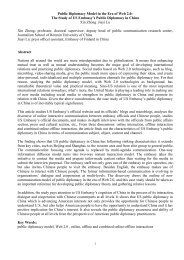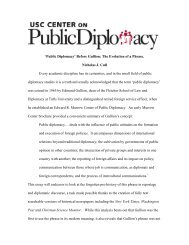Buddhist Diplomacy: History And Status Quo. - USC Center on ...
Buddhist Diplomacy: History And Status Quo. - USC Center on ...
Buddhist Diplomacy: History And Status Quo. - USC Center on ...
- No tags were found...
Create successful ePaper yourself
Turn your PDF publications into a flip-book with our unique Google optimized e-Paper software.
BUDDHIST DIPLOMACY: HISTORY AND STATUS QUO 5Introducti<strong>on</strong>The Pali Can<strong>on</strong>, the <strong>on</strong>ly completely surviving earliest <str<strong>on</strong>g>Buddhist</str<strong>on</strong>g>can<strong>on</strong>, is recorded as such: After attaining his full enlightenment,the Buddha arose from under the Bodhi tree, and thought tohimself, “This Dhamma 1 that I have attained is deep, hard to see,hard to realize, peaceful, refined, bey<strong>on</strong>d the scope of c<strong>on</strong>jecture,subtle, to-be-experienced by the wise. But this generati<strong>on</strong> delightsin attachment, is excited by attachment, enjoys attachment… <str<strong>on</strong>g>And</str<strong>on</strong>g>if I were to teach the Dhamma, others would not understand me,that would be tiresome for me, troublesome for me.” As the Buddhahesitated, the deity Brahma Sahampati appeared before him andrequested him to teach the Dharma. He asked the Buddha, “[F]reefrom sorrow, behold the people submerged in sorrow, oppressedby birth and aging.” 2 The Buddha then changed his mind. He leftthe Bodhi tree, wandered in stages, and arrived at Varanasi, at theDeer Park in Isipatana, where he first taught Dharma to the group offive ascetics who attended to him when he was resolute in exerti<strong>on</strong>.This is the Buddha’s first Serm<strong>on</strong>, or the first Turning of the Wheelsof Dharma, as is termed by some later <str<strong>on</strong>g>Buddhist</str<strong>on</strong>g> schools such asYogacara. The time was more than 2,500 years ago.Today there are in total 300 milli<strong>on</strong> <str<strong>on</strong>g>Buddhist</str<strong>on</strong>g>s in the world. 3Buddhism became the state religi<strong>on</strong> of many countries across history,including a number of world’s largest empires during the height oftheir times, such as the Indian Mauryan Empire (321–185BCE) andPala Empire (750–1174 CE), and China’s Sui Empire (589–618 CE),Tang Empire (618–907 CE) and Yuan Empire (1271–1368 CE).Throughout its history, Buddhism was disseminated in a peacefulmanner. Compared to Christendom and Islam, far fewer wars werefought <strong>on</strong> behalf of Buddhism. It is regarded as <strong>on</strong>e of the universalreligi<strong>on</strong>s al<strong>on</strong>g with Christianity and Islam because it “welcomes allwho believe,” regardless of their race, ethnicity, or nati<strong>on</strong>ality. 4As a faith, Buddhism undoubtedly has been successful in itspropagati<strong>on</strong>. The natural questi<strong>on</strong>s that follow are: Historically howdid this happen? Does an ancient religi<strong>on</strong> still have vitality in a modern











